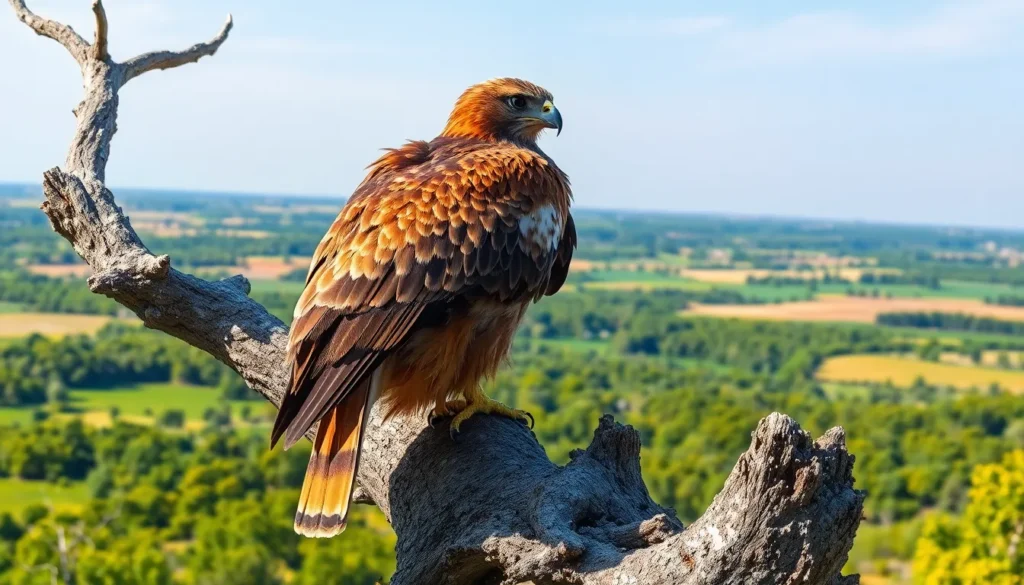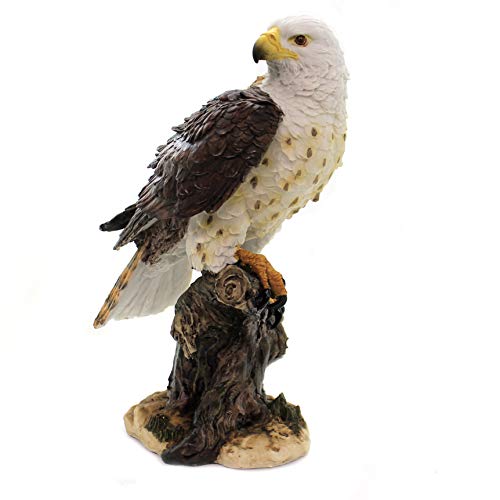Hawks are among nature’s most impressive aerial predators, and we’re fascinated by their incredible hunting prowess and majestic flight patterns. These powerful raptors dominate skies across North America with their razor-sharp talons, exceptional eyesight, and lightning-fast diving speeds that can exceed 120 miles per hour.
We’ve observed countless hawks in action, and their adaptability never ceases to amaze us. From the common Red-tailed Hawk soaring over suburban neighborhoods to the agile Cooper’s Hawk handling dense forests, these birds have mastered virtually every habitat across the continent.
Whether you’re a seasoned birdwatcher or simply curious about the hawks circling overhead in your backyard, we’ll guide you through everything you need to know about these remarkable creatures. You’ll discover their hunting techniques, nesting behaviors, and learn how to identify different hawk species with confidence.
What Is a Hawk Bird
Hawks represent a diverse group of raptors belonging to the Accipitridae family, encompassing over 270 species worldwide. These magnificent predators showcase remarkable hunting abilities through their razor-sharp talons, powerful wings, and exceptional visual acuity that surpasses human vision by 8 times.
Medium-sized birds of prey, hawks typically measure between 8 to 26 inches in length with wingspans ranging from 18 to 55 inches depending on the species. Buteo hawks like the Red-tailed Hawk display broader wings and stockier builds, while Accipiter hawks such as the Sharp-shinned Hawk feature more slender profiles with shorter, rounded wings designed for forest navigation.
Distinguished features of hawk birds include hooked beaks perfectly adapted for tearing flesh, forward-facing eyes that provide superior depth perception, and powerful feet equipped with four curved talons. Their streamlined bodies enable diving speeds reaching up to 150 mph during hunting pursuits, making them among nature’s most efficient aerial predators.
Geographic distribution of hawk species spans every continent except Antarctica, with North America hosting 19 distinct species. Desert regions support Harris’s Hawks in cooperative hunting groups, while dense woodlands shelter Cooper’s Hawks as they pursue songbirds through intricate branch networks.
| Hawk Characteristic | Range/Measurement |
|---|---|
| Species Count Worldwide | 270+ species |
| Length Range | 8-26 inches |
| Wingspan Range | 18-55 inches |
| Vision Superiority | 8x better than humans |
| Maximum Diving Speed | 150 mph |
| North American Species | 19 species |
Behavioral patterns distinguish hawks from other raptors through their soaring hunting style and territorial nature. Broad-winged Hawks demonstrate remarkable migration abilities, traveling over 4,000 miles annually in flocks called kettles, while year-round residents like Red-shouldered Hawks maintain established territories spanning 100 to 400 acres.
Physical Characteristics of Hawks
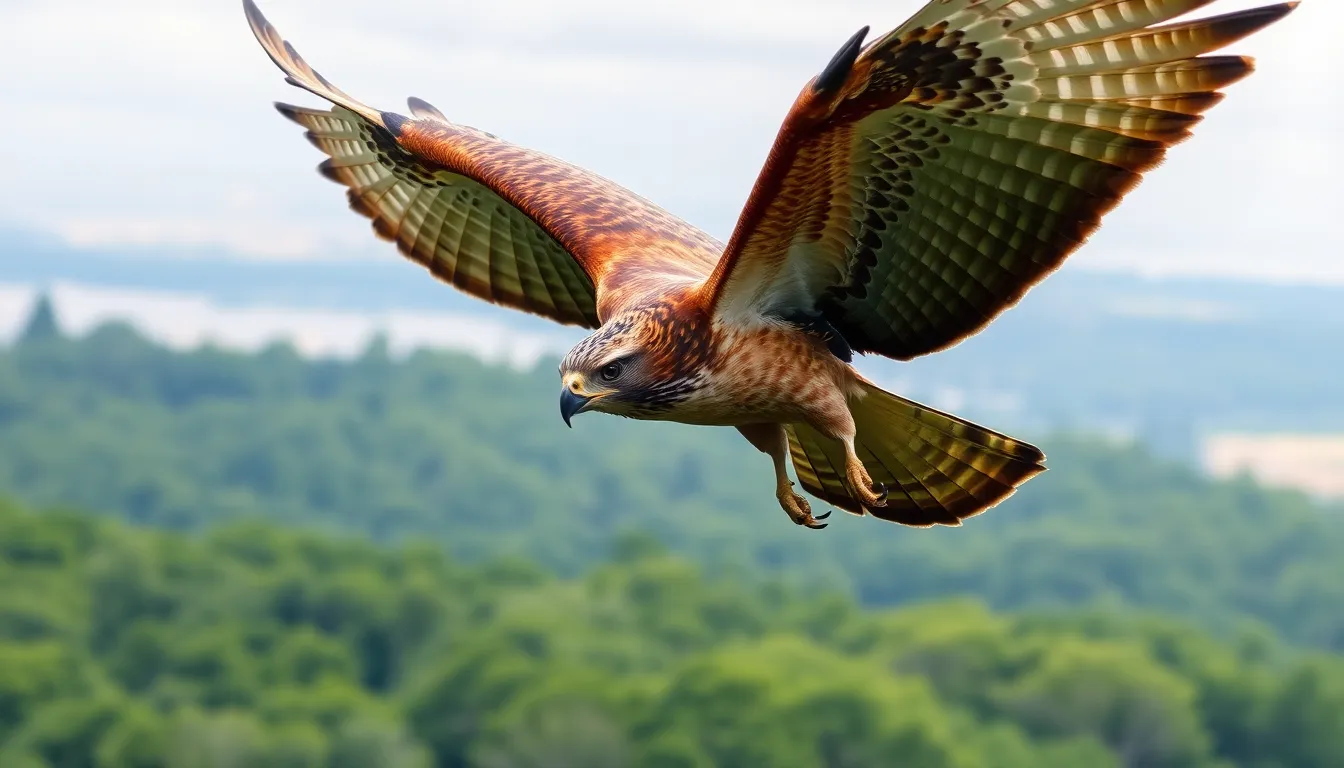
Hawks possess distinctive anatomical features that make them perfectly suited for their predatory lifestyle. These remarkable raptors showcase incredible physical variations across species while maintaining consistent traits that define their hunting prowess.
Size and Build
Medium-sized proportions characterize most hawk species, with body lengths ranging from 8 inches in smaller species like the Sharp-shinned Hawk to 26 inches in larger varieties such as the Ferruginous Hawk. Wingspans demonstrate even greater variation, extending from 18 inches in compact woodland species to an impressive 55 inches in broad-winged prairie hunters.
| Hawk Species | Body Length | Wingspan | Weight Range |
|---|---|---|---|
| Sharp-shinned Hawk | 9-13 inches | 17-22 inches | 3-7 oz |
| Cooper’s Hawk | 14-20 inches | 24-35 inches | 8-24 oz |
| Red-tailed Hawk | 17-22 inches | 38-43 inches | 1.5-3.5 lbs |
| Ferruginous Hawk | 22-27 inches | 53-56 inches | 2-5 lbs |
Robust chest muscles power their flight capabilities while compact builds enable swift maneuvering through dense vegetation. Broad-winged species excel at soaring and long-distance flight, whereas narrow-winged hawks demonstrate superior agility in confined spaces.
Distinctive Features
Razor-sharp talons serve as primary hunting weapons, measuring up to 2 inches in length on larger species and capable of exerting crushing pressure exceeding 400 pounds per square inch. Four toes on each foot provide optimal grip strength, with three facing forward and one backward for maximum prey retention.
Hooked beaks feature needle-sharp points designed for tearing flesh, while powerful jaw muscles generate sufficient force to dismember prey efficiently. Eye positioning on the front of their heads creates binocular vision spanning approximately 35-50 degrees, enabling precise depth perception crucial for successful strikes.
Exceptional eyesight represents their most remarkable sensory adaptation, with visual acuity reaching 8 times greater clarity than human vision. Dense concentrations of photoreceptors in their retinas allow detection of small movements from distances exceeding 2 miles, while specialized eye muscles help rapid focus adjustments during high-speed pursuits.
Feather patterns vary dramatically between species, with coloration ranging from rich reddish-brown in Red-tailed Hawks to striking blue-gray in Cooper’s Hawks. Adult plumage typically displays more defined markings and vibrant colors compared to juvenile birds, which often exhibit streaked brown patterns providing camouflage during their vulnerable first year.
Different Types of Hawk Birds
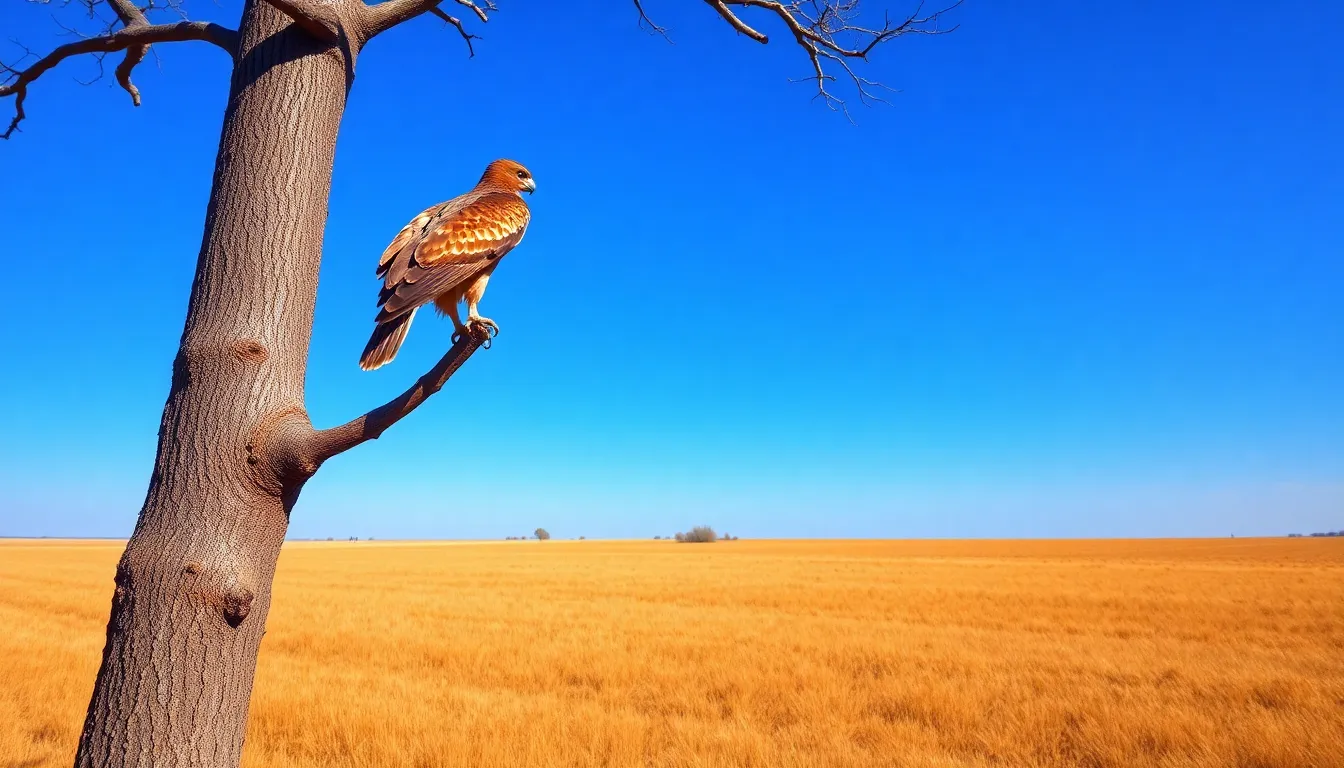
Hawks cover many species across North America, each adapted to exact hunting environments and prey preferences. We examine three prominent hawk species that demonstrate the remarkable diversity within this raptor family.
Red-Tailed Hawks
Red-tailed Hawks represent the most widespread hawk species in North America, occupying territories from Alaska to Panama. These robust raptors measure 17-22 inches in length with wingspans reaching 44-53 inches, making them ideal for soaring across open landscapes. We observe their distinctive rusty-red tail feathers on adult birds, while juveniles display brown-banded tails that develop the characteristic coloration after their first year.
Open fields, prairies, and woodland edges serve as primary hunting grounds for Red-tailed Hawks. Their broad wings enable effortless soaring at altitudes up to 500 feet while scanning for rodents, rabbits, and snakes below. These adaptable hunters perch on fence posts, telephone poles, and tall trees for extended periods, demonstrating patience that often rewards them with successful captures.
Breeding pairs establish territories spanning 1-2 square miles during nesting season from March through July. Red-tailed Hawks construct large stick nests in tall trees, often reusing and expanding the same structure across multiple years. Females typically lay 2-3 eggs, with incubation lasting 28-35 days before chicks emerge.
Cooper’s Hawks
Cooper’s Hawks excel as woodland specialists, maneuvering through dense forests with remarkable agility even though measuring 14-20 inches in length. Their shorter wings (24-35 inch wingspan) and longer tails provide exceptional steering control between trees and branches. We identify these medium-sized raptors by their blue-gray backs, rusty-barred breasts, and distinctive white undertail coverts.
Bird species comprise 90% of Cooper’s Hawk diets, with songbirds, woodpeckers, and occasionally small mammals falling victim to their surprise attacks. These accipiters employ stealth hunting techniques, approaching prey through concealed flight paths before executing rapid strikes. Urban environments increasingly attract Cooper’s Hawks due to abundant bird populations around feeders and nest boxes.
Nesting occurs in dense tree canopies between April and August, with pairs constructing platforms of sticks lined with bark and green vegetation. Cooper’s Hawks demonstrate strong site fidelity, often returning to successful nesting areas year after year. Females produce clutches of 3-5 eggs, requiring 32-36 days of incubation.
Sharp-Shinned Hawks
Sharp-shinned Hawks rank as North America’s smallest accipiter, with females measuring 9-13 inches and males reaching only 8-10 inches in length. Their compact size (17-23 inch wingspan) enables pursuit of small songbirds through thick vegetation where larger hawks cannot follow. We distinguish Sharp-shinned Hawks from Cooper’s Hawks by their square-tipped tails and smaller heads that barely extend beyond their wings during flight.
Coniferous and mixed forests provide ideal habitat for Sharp-shinned Hawks, particularly during breeding season from May through July. These agile hunters specialize in capturing warblers, sparrows, and thrushes through high-speed chases among tree branches. Migration brings Sharp-shinned Hawks to suburban areas where bird feeders concentrate potential prey.
Dense conifer groves house their stick nests, typically positioned 10-60 feet above ground against tree trunks. Sharp-shinned Hawk pairs produce 4-5 eggs annually, with females handling most incubation duties over 30-35 days. Northern populations migrate substantial distances, with some individuals traveling over 3,000 miles between breeding and wintering grounds.
Hawk Bird Habitat and Distribution
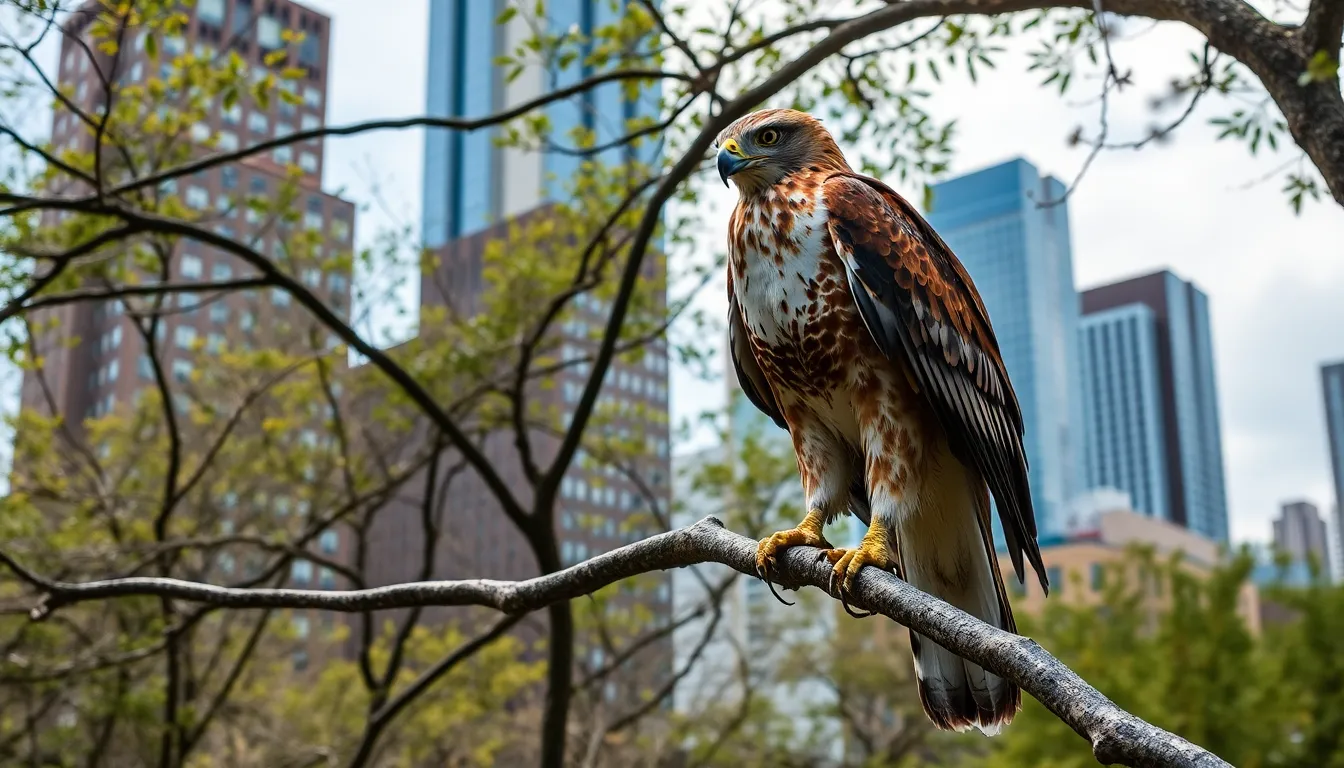
Hawk birds occupy diverse ecosystems across North America, from dense woodlands to expansive grasslands. These adaptable raptors establish territories in environments ranging from sea level to elevations exceeding 10,000 feet. Urban areas increasingly support hawk populations, with cities like New York and Chicago hosting thriving Red-tailed Hawk communities.
Continental Range Patterns
North American hawk distribution spans from Alaska’s boreal forests to Mexico’s tropical regions. Red-tailed Hawks claim the broadest territory, inhabiting every U.S. state and most Canadian provinces. Cooper’s Hawks concentrate in wooded areas throughout the continental United States and southern Canada. Sharp-shinned Hawks extend their range from northern Alaska to Central America, following prey availability.
| Hawk Species | Geographic Range | Primary Habitat | Elevation Range |
|---|---|---|---|
| Red-tailed Hawk | Alaska to Panama | Mixed habitats | Sea level to 14,000 feet |
| Cooper’s Hawk | Southern Canada to Mexico | Woodlands | Sea level to 9,000 feet |
| Sharp-shinned Hawk | Alaska to Guatemala | Dense forests | Sea level to 10,000 feet |
| Ferruginous Hawk | Western North America | Open grasslands | 1,000 to 8,000 feet |
Habitat Preferences by Species
Woodland hawks like Cooper’s Hawks prefer mature forests with dense canopy cover and established flight corridors. These environments provide optimal hunting conditions for pursuing songbirds through tree branches. Sharp-shinned Hawks select similar habitats but favor younger forests with thicker understory vegetation.
Open country species demonstrate different habitat requirements across various landscapes. Red-tailed Hawks thrive in agricultural areas, grasslands and forest edges where small mammals remain abundant. Ferruginous Hawks occupy vast prairie ecosystems, requiring territories spanning 2 to 6 square miles for successful breeding.
Seasonal Distribution Changes
Migration patterns significantly alter hawk distribution throughout the year across different regions. Broad-winged Hawks abandon northern breeding grounds each autumn, traveling to Central and South American wintering areas. These movements create spectacular concentrations at geographic bottlenecks like Hawk Mountain in Pennsylvania, where observers count over 20,000 migrating raptors annually.
Year-round residents maintain consistent territories regardless of seasonal changes in weather conditions. Red-shouldered Hawks occupy the same woodland areas throughout all seasons, adapting their hunting strategies to available prey. Cooper’s Hawks display partial migration patterns, with northern populations moving south while southern birds remain stationary.
Urban Adaptation Success
City environments increasingly support hawk populations through abundant food sources and nesting opportunities. Building ledges substitute for natural cliff faces, while parks provide hunting grounds comparable to forest clearings. Peregrine Falcons, though technically falcons rather than hawks, demonstrate similar urban success stories in cities worldwide.
Urban hawk territories typically measure smaller than rural counterparts due to concentrated prey availability. Red-tailed Hawks in Manhattan’s Central Park maintain territories of approximately 25 acres, compared to 100+ acres in rural settings. These compressed ranges reflect higher prey density in metropolitan environments.
Hunting Behavior and Diet
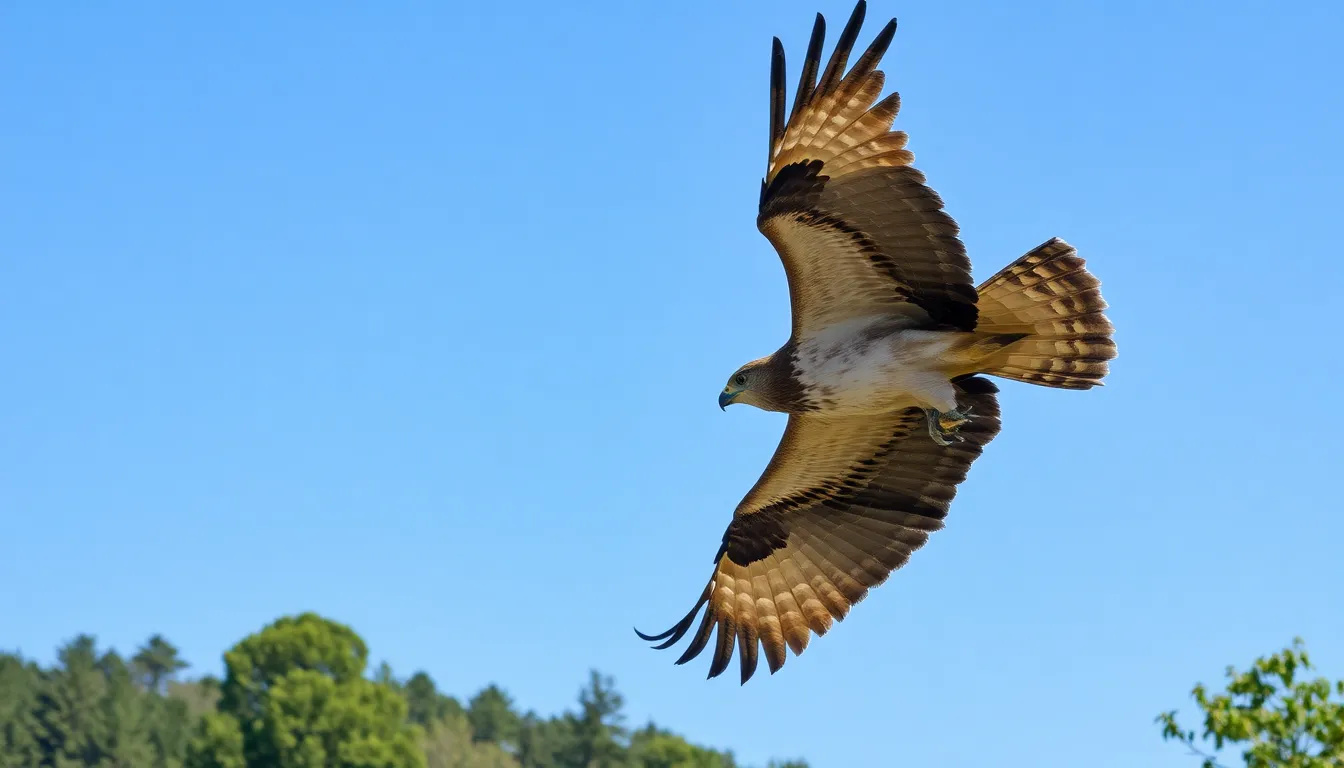
Hawks demonstrate remarkable predatory efficiency through specialized hunting strategies and selective dietary preferences. We observe these raptors employing diverse techniques that capitalize on their exceptional physical attributes and acute sensory capabilities.
Hunting Techniques
Soaring and scanning forms the primary hunting method for most hawk species across North America. Red-tailed Hawks use thermal updrafts to circle at altitudes between 500 to 2,000 feet while scanning territories spanning 1 to 3 square miles. Cooper’s Hawks employ stealth ambush tactics by remaining motionless on concealed perches for 10 to 45 minutes before launching surprise attacks. These woodland specialists approach prey at speeds reaching 35 mph through dense vegetation.
High-speed pursuit characterizes the hunting style of Sharp-shinned Hawks in forested environments. These agile raptors weave between tree branches at 25 mph while chasing songbirds through obstacle courses of leaves and branches. Stooping dives represent the most dramatic hunting technique among larger hawk species. Ferruginous Hawks execute vertical descents from heights exceeding 1,000 feet at speeds approaching 120 mph when targeting ground-dwelling prey.
Ground hunting occurs when hawks detect movement in grass or leaf litter from elevated positions. Red-shouldered Hawks walk methodically across forest floors to capture amphibians and small mammals hiding beneath vegetation. Kleptoparasitism involves hawks stealing prey from smaller raptors like kestrels or owls during territorial encounters.
Prey Selection
Small mammals constitute 60 to 80 percent of the diet for most hawk species throughout North America. Red-tailed Hawks primarily target rodents weighing 2 to 16 ounces including voles, mice, ground squirrels, and young rabbits. Cooper’s Hawks focus predominantly on medium-sized birds ranging from 1 to 8 ounces such as robins, jays, doves, and woodpeckers.
Reptiles and amphibians provide seasonal protein sources for hawks inhabiting wetland and woodland edges. Red-shouldered Hawks consume salamanders, frogs, snakes, and lizards during spring and summer months when these prey species are most active. Fish represents an opportunistic food source for hawks nesting near water bodies. Broad-winged Hawks occasionally wade in shallow streams to capture minnows and tadpoles.
Insects supplement hawk diets during peak summer abundance periods. Sharp-shinned Hawks consume grasshoppers, beetles, and dragonflies when vertebrate prey becomes scarce. Carrion serves as an alternative food source during harsh weather conditions when live hunting proves difficult. Red-tailed Hawks scavenge roadkill and winter-killed deer carcasses during months with limited prey availability.
| Prey Category | Percentage of Diet | Primary Hawk Species | Average Prey Weight |
|---|---|---|---|
| Small mammals | 60-80% | Red-tailed, Ferruginous | 2-16 oz |
| Medium birds | 70-90% | Cooper’s, Sharp-shinned | 1-8 oz |
| Reptiles/amphibians | 15-30% | Red-shouldered, Broad-winged | 0.5-4 oz |
| Fish | 5-15% | Red-shouldered, Broad-winged | 1-6 oz |
| Insects | 5-20% | All species (seasonal) | <1 oz |
Hawk Bird Life Cycle and Reproduction
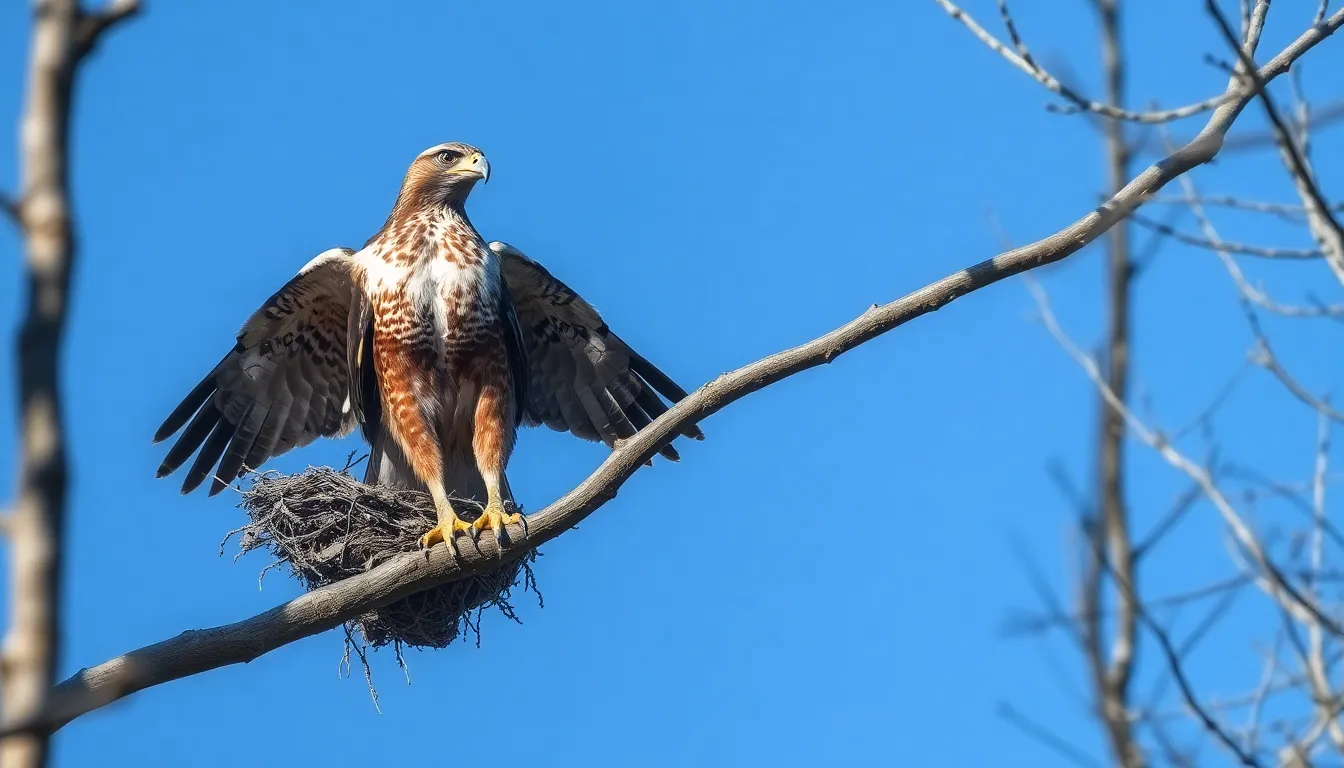
Hawks demonstrate remarkable breeding behaviors that ensure the survival of their species across diverse environments. These raptors follow exact reproductive cycles that vary by species but share common elements in courtship, nesting, and parental care.
Mating Rituals
Spectacular aerial displays mark the beginning of hawk breeding season, typically occurring between February and June depending on the species and geographic location. Male hawks initiate courtship through dramatic sky dances that include high soaring, steep dives, and intricate flight patterns designed to attract potential mates. Red-tailed Hawks perform figure-eight patterns while calling loudly, reaching altitudes of 1,000 feet before executing breathtaking dives toward their chosen females.
Pair bonding strengthens through mutual soaring sessions where both birds fly in synchronized circles, often locking talons briefly while cartwheeling through the air. Cooper’s Hawks engage in stick-passing ceremonies where males present nesting materials to females as courtship gifts. Vocalizations play a crucial role during this period, with each species producing distinct calls that range from harsh screams to soft chirping sounds.
Territory establishment occurs simultaneously with courtship activities, as mated pairs defend areas spanning 1 to 5 square miles depending on prey availability and habitat quality. Sharp-shinned Hawks maintain smaller territories of approximately 0.5 square miles due to their woodland habitat preferences. Aggressive behaviors toward intruders intensify during breeding season, with pairs working together to chase away competing hawks and other predators.
Nesting and Young Care
Nest construction begins immediately after successful pair formation, with both hawks contributing to building sturdy platforms that can support growing families. Most species choose locations 20 to 60 feet above ground in tall trees, constructing nests measuring 24 to 36 inches in diameter using twigs, bark strips, and moss. Red-tailed Hawks often reuse and expand existing nests each year, creating massive structures that can reach 3 feet in height after multiple breeding seasons.
Egg laying occurs 2 to 4 weeks after nest completion, with clutch sizes varying by species and environmental conditions. Cooper’s Hawks typically lay 3 to 5 pale blue eggs marked with brown spots, while Red-tailed Hawks produce 1 to 3 creamy white eggs with reddish-brown markings. Incubation periods last 28 to 35 days, with females handling most brooding duties while males provide food deliveries.
Hatching produces helpless chicks covered in white down feathers, requiring intensive parental care for survival. Parents alternate hunting and guarding responsibilities, with males typically bringing prey while females tear food into appropriate sizes for feeding. Nestling development progresses rapidly, with flight feathers emerging after 3 to 4 weeks and fledging occurring between 4 to 7 weeks depending on species size.
Post-fledging care extends for additional 4 to 8 weeks as young hawks learn essential hunting skills from their parents. Family groups remain together throughout this period, with adults demonstrating prey capture techniques and territorial boundaries. Juvenile hawks achieve full independence by late summer or early fall, dispersing to establish their own territories and beginning the cycle anew upon reaching sexual maturity at 1 to 2 years of age.
Hawks in Different Ecosystems
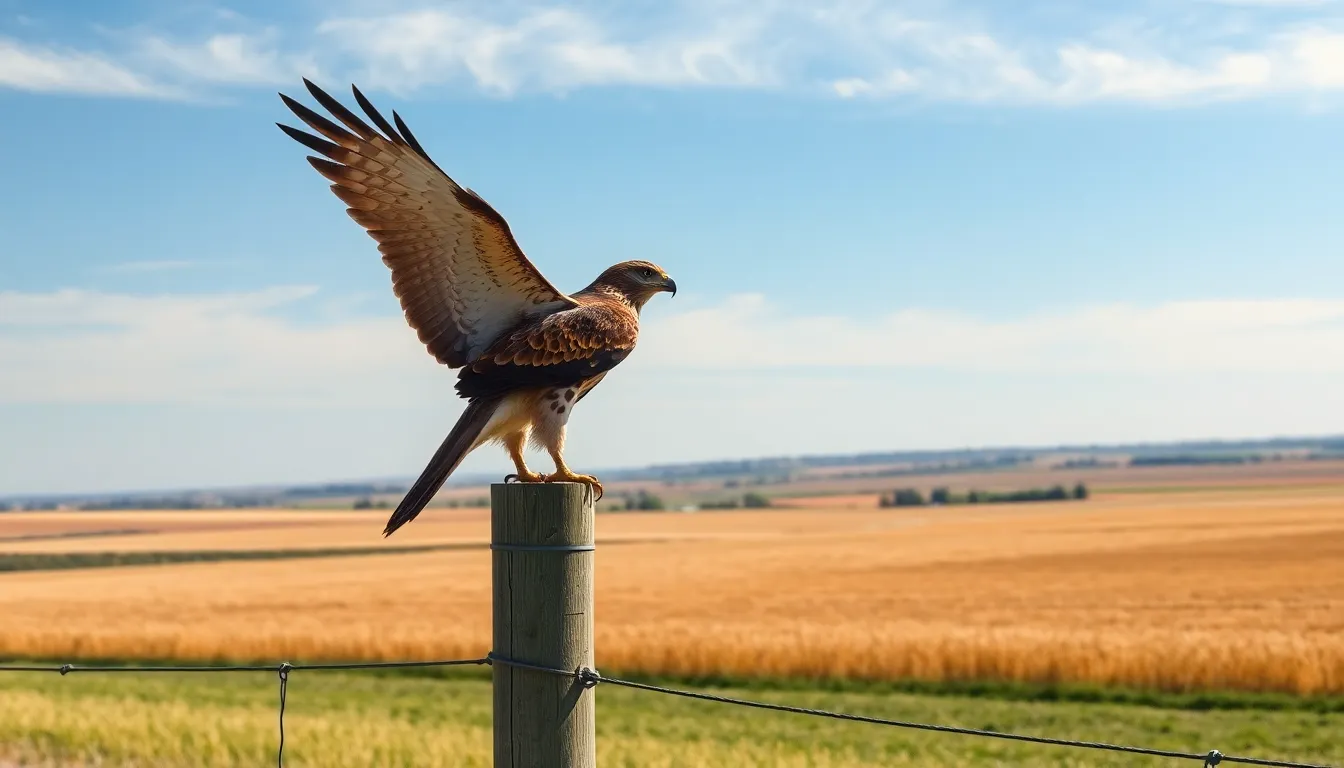
Hawk species demonstrate remarkable adaptability across diverse North American ecosystems, establishing territories from Arctic tundra to tropical wetlands. Forest environments support the highest hawk species diversity, with dense canopy layers providing optimal nesting sites and abundant prey populations. Red-shouldered Hawks dominate eastern deciduous forests where they hunt amphibians and small mammals along stream corridors.
Woodland ecosystems host specialized hunters like Cooper’s Hawks and Sharp-shinned Hawks that navigate through tight tree spacing with exceptional agility. These accipiter species use understory vegetation for concealment while pursuing songbirds through complex branch networks. Northern Goshawks patrol mature coniferous forests across Canada and Alaska, defending territories spanning 1,000 to 6,000 acres per breeding pair.
Grassland habitats support different hawk communities adapted to open terrain hunting strategies. Ferruginous Hawks thrive in western prairies where they target ground squirrels and prairie dogs from elevated perches or soaring flights. Red-tailed Hawks achieve their highest population densities in mixed grassland environments that combine open hunting grounds with scattered trees for nesting.
Desert ecosystems present unique challenges that certain hawk species overcome through specialized adaptations. Harris’s Hawks form cooperative hunting groups in Sonoran Desert regions, working together to capture jackrabbits and other large prey. Zone-tailed Hawks mimic turkey vultures in southwestern deserts, using this deception to approach unsuspecting lizards and small birds.
Wetland environments attract hawks that specialize in aquatic prey species. Northern Harriers patrol marsh edges using low, coursing flight patterns to surprise frogs, small fish, and waterfowl. These raptors nest on the ground in dense cattail stands, creating platform structures above seasonal flood levels.
Urban ecosystems increasingly support hawk populations that adapt to city living conditions. Cooper’s Hawks nest on building fire escapes and hunt pigeons in downtown areas, while Red-tailed Hawks establish territories in large city parks. Urban hawk pairs often raise more successful broods due to reduced predation pressure and consistent food sources from abundant city wildlife.
| Network Type | Primary Hawk Species | Territory Size (acres) | Main Prey Categories |
|---|---|---|---|
| Deciduous Forest | Red-shouldered Hawk | 200-400 | Amphibians, small mammals |
| Coniferous Forest | Northern Goshawk | 1,000-6,000 | Medium birds, mammals |
| Grasslands | Ferruginous Hawk | 2,000-8,000 | Ground squirrels, prairie dogs |
| Desert | Harris’s Hawk | 300-1,500 | Rabbits, lizards |
| Wetlands | Northern Harrier | 50-200 | Frogs, small birds |
| Urban Areas | Cooper’s Hawk | 25-75 | Pigeons, songbirds |
Mountain ecosystems support hawk species that handle extreme elevation changes and harsh weather conditions. Rough-legged Hawks migrate from Arctic breeding grounds to winter in high elevation meadows and agricultural valleys. These northern visitors hunt small mammals in open mountain terrain using hovering flight techniques uncommon among other hawk species.
Coastal environments provide seasonal opportunities for migrating hawk populations during spring and fall movements. Broad-winged Hawks concentrate along Atlantic shorelines in massive flocks called kettles, containing thousands of individuals riding thermal updrafts. Sharp-shinned Hawks follow coastal flyways where they intercept migrating songbirds moving along shoreline corridors.
Agricultural landscapes create modified ecosystems where adaptable hawk species establish hunting territories. Red-tailed Hawks use farm fence posts as hunting perches while scanning crop fields for rodents. These human-altered environments often support higher prey densities than natural habitats, leading to increased hawk breeding success rates in suitable agricultural regions.
Conservation Status of Hawk Birds
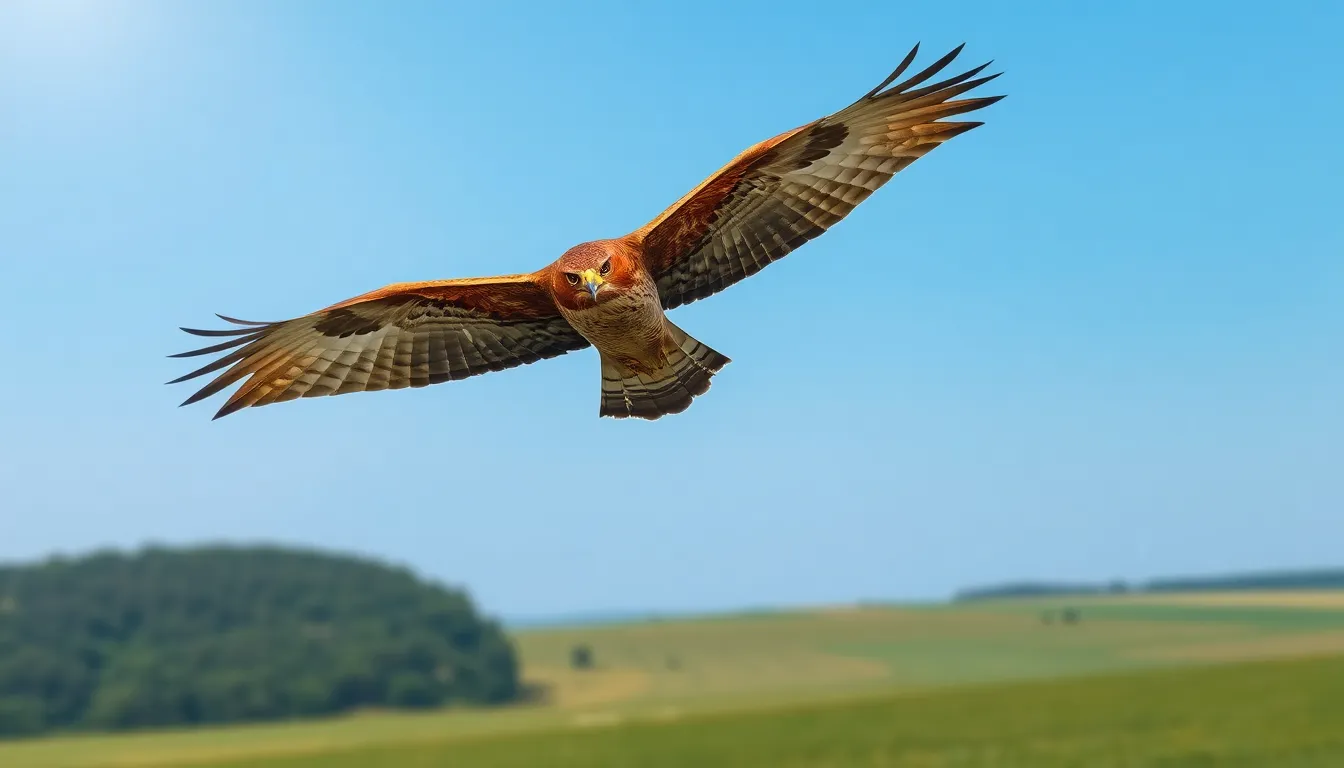
Current conservation assessments reveal that most North American hawk species maintain stable populations across their ranges. The International Union for Conservation of Nature (IUCN) classifies 85% of hawk species as “Least Concern” on their Red List of Threatened Species.
Population Trends Across Species
Red-tailed Hawks demonstrate remarkable population stability with an estimated 2.3 million breeding pairs in North America. Cooper’s Hawks have experienced important recovery since the 1970s, increasing by approximately 1.8% annually over the past five decades. Sharp-shinned Hawk populations remain steady even though slight regional variations in breeding success rates.
Species Population Data:
| Species | Population Estimate | IUCN Status | Trend |
|---|---|---|---|
| Red-tailed Hawk | 2.3 million pairs | Least Concern | Stable |
| Cooper’s Hawk | 700,000 pairs | Least Concern | Increasing |
| Sharp-shinned Hawk | 500,000 pairs | Least Concern | Stable |
| Ferruginous Hawk | 75,000 pairs | Near Threatened | Declining |
| Northern Goshawk | 150,000 pairs | Least Concern | Stable |
Historical Conservation Challenges
DDT pesticide use between 1940 and 1972 caused dramatic population declines in multiple hawk species. Chemical accumulation in prey animals led to eggshell thinning and reproductive failures among raptors. Federal protection under the Migratory Bird Treaty Act in 1972 marked a turning point for hawk conservation efforts.
Recovery programs implemented after pesticide bans showed measurable success within two decades. Cooper’s Hawks experienced population increases of 300% in eastern regions following DDT restrictions. Sharp-shinned Hawks recovered more slowly due to their specialized woodland habitat requirements.
Current Threats and Protection Measures
Habitat fragmentation poses the primary challenge for hawk conservation in agricultural and urban development areas. Ferruginous Hawks face important pressure from grassland conversion, with 68% of their native prairie habitat altered for farming operations. Northern Goshawks encounter logging impacts in mature forest ecosystems where they establish breeding territories.
Wind energy installations create collision risks for migrating hawk populations. Research indicates that properly sited turbines reduce mortality rates by 70% compared to poorly planned installations. Federal guidelines now require environmental assessments before wind farm construction in critical hawk migration corridors.
Regional Conservation Initiatives
State wildlife agencies monitor hawk populations through annual breeding bird surveys and migration counts. Hawk Mountain Sanctuary in Pennsylvania records over 20,000 migrating raptors annually, providing crucial long-term population data. Regional partnerships coordinate habitat restoration projects across state boundaries to maintain connected wildlife corridors.
Urban conservation programs create nesting opportunities for Cooper’s Hawks and Sharp-shinned Hawks in metropolitan areas. Cities like New York and Chicago carry out bird-friendly building designs that reduce collision deaths by 40%. Public education campaigns increase awareness about hawk conservation among urban residents.
International Conservation Efforts
Migratory hawk species benefit from international agreements protecting their winter ranges in Central and South America. The Partners in Flight initiative coordinates conservation strategies across national borders for Broad-winged Hawks and other long-distance migrants. Habitat protection in tropical wintering grounds directly impacts North American breeding populations.
Conservation funding through the North American Bird Conservation Initiative supports research and habitat management projects. Private organizations contribute $15 million annually to hawk research and protection programs. Citizen science projects engage thousands of volunteers in hawk monitoring efforts across the continent.
Hawks and Human Interaction
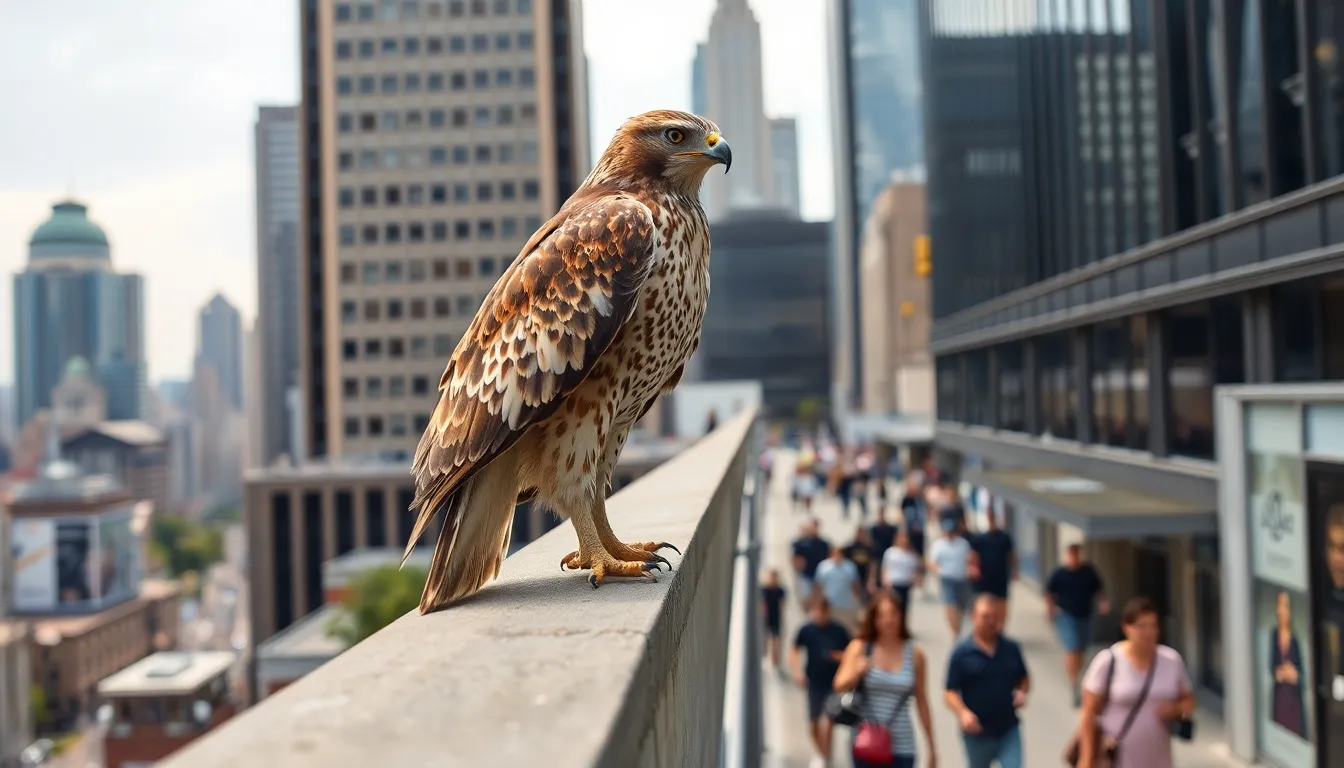
Hawks demonstrate remarkable adaptability in modern human-dominated landscapes. These raptors increasingly thrive alongside our communities while maintaining their traditional roles in falconry practices.
Urban Hawks
Urban environments create unique opportunities for hawk species to establish territories within city boundaries. Cooper’s Hawks lead this urban adaptation with populations increasing 81% in metropolitan areas since 1995 according to the North American Breeding Bird Survey. Red-tailed Hawks occupy downtown districts by nesting on building ledges and hunting in parks where prey density reaches 2.3 times higher concentrations than rural habitats.
City-dwelling hawks modify their hunting schedules to align with human activity patterns. Morning hunting sessions occur between 6:00 AM and 9:00 AM when joggers flush ground prey from park areas. Evening hunts resume from 4:00 PM to 7:00 PM as pedestrians create disturbances that expose rodents and small birds.
Building structures provide optimal nesting sites with Red-tailed Hawks selecting locations 45-120 feet above street level. Fire escapes offer convenient access points while rooftop HVAC units create wind barriers that protect nests from weather exposure. Cooper’s Hawks prefer dense tree canopies in residential neighborhoods where backyard bird feeders concentrate songbird populations.
Urban hawks face exact challenges including window collisions affecting 12% of juvenile birds annually. Glass reflections confuse hunting hawks during pursuit sequences particularly in downtown areas with extensive mirror facades. Traffic noise levels averaging 65-75 decibels alter communication patterns between mates and offspring.
City hawks develop tolerance to human proximity with some individuals maintaining territories within 150 feet of busy sidewalks. Park benches become regular perching spots where hawks observe foot traffic while scanning for prey opportunities. These adaptations demonstrate remarkable behavioral plasticity as urban populations continue expanding across North American cities.
Hawks in Falconry
Falconry traditions spanning 4000 years establish hawks as premier hunting partners for experienced practitioners. Red-tailed Hawks represent 67% of all falconry birds in North America due to their trainability and robust temperament. Harris’s Hawks excel in collaborative hunting scenarios with falconers achieving 73% success rates during rabbit hunts.
Training protocols begin with weight management techniques that maintain hawks at 85-90% of their natural body weight. Daily flying sessions lasting 45-60 minutes develop the human-hawk partnership through consistent food rewards. Glove training requires 2-3 weeks of gradual conditioning before hawks accept extended handling periods.
Modern falconry equipment includes GPS telemetry systems that track hawk movements within 10-meter accuracy ranges. Radio transmitters weighing 8-12 grams attach to tail feathers allowing recovery of birds that pursue prey beyond visual range. Leather gloves constructed from elk hide provide protection against talons exerting 400 pounds per square inch of pressure.
Licensed falconers undergo rigorous certification processes including 100-hour apprenticeships under master falconers. Written examinations cover raptor biology anatomy hunting behavior and federal regulations governing bird possession. Annual inspections ensure proper housing facilities meet minimum standards of 8x8x8 feet for medium-sized hawk species.
Conservation benefits emerge from falconry programs that contribute rehabilitated birds to wild populations. Captive breeding initiatives produce 340 hawks annually for release programs supporting species recovery efforts. Educational demonstrations at schools and nature centers reach 125000 people yearly promoting raptor conservation awareness.
Wild hawk populations benefit from falconry research that advances veterinary techniques and behavioral understanding. Tracking studies using falconry-trained birds provide migration data and habitat preferences that inform conservation strategies. These partnerships between falconers and researchers strengthen protection efforts for hawk species across their natural ranges.
Conclusion
Hawks remain one of nature’s most remarkable success stories demonstrating incredible adaptability and resilience across North America. We’ve witnessed their ability to thrive in environments ranging from pristine wilderness areas to bustling urban centers showcasing their evolutionary flexibility.
These magnificent raptors continue to play crucial roles as network indicators and population controllers while maintaining stable numbers across most species. Their recovery from historical challenges like DDT contamination proves that dedicated conservation efforts can yield remarkable results.
Whether we encounter them soaring over prairie grasslands or perched on city buildings hawks remind us of the ever-changing relationship between wildlife and human development. Their presence enriches our natural heritage and offers countless opportunities for observation education and appreciation of the intricate web of life that surrounds us.
Frequently Asked Questions
What is the size range of hawks in North America?
Hawks are medium-sized birds of prey with body lengths ranging from 8 to 26 inches. The smallest species, like the Sharp-shinned Hawk, measure around 8 inches, while larger varieties such as the Ferruginous Hawk can reach 26 inches. Their wingspans vary significantly from 18 to 55 inches depending on the species.
How fast can hawks fly and dive?
Hawks can reach incredible diving speeds of up to 150 mph when hunting prey. Their robust chest muscles and compact builds allow for swift maneuvering during flight. Different species have varying flight capabilities, with larger hawks typically achieving higher speeds during their dramatic stooping dives.
What do hawks primarily eat?
Hawks have diverse diets consisting mainly of small mammals, medium-sized birds, reptiles, amphibians, fish, and insects. Red-tailed Hawks focus primarily on rodents, while Cooper’s Hawks specialize in hunting birds. Their prey selection depends on their habitat, hunting style, and species-specific adaptations.
How good is hawk eyesight compared to humans?
Hawks possess exceptional visual acuity that is eight times better than human eyesight. This remarkable vision allows them to detect small movements from great distances while soaring high above their hunting territories. Their superior eyesight is one of their most important adaptations for successful predation.
Where do hawks typically build their nests?
Hawks construct their nests high in trees, with both parents contributing to building sturdy structures. In urban environments, they’ve adapted to nest on building ledges and other elevated structures. Nest construction follows successful pair formation and occurs during their breeding season between February and June.
Are hawk populations currently stable?
Most North American hawk species maintain stable populations, with 85% classified as “Least Concern” by the IUCN. Red-tailed Hawks have an estimated 2.3 million breeding pairs, and Cooper’s Hawks have shown significant recovery since the 1970s, with an 81% population increase in metropolitan areas since 1995.
Do hawks migrate or stay in one area year-round?
Migration patterns vary by species. Some hawks like the Broad-winged Hawk migrate to Central and South America for winter, while others such as Red-shouldered Hawks remain year-round residents in their established territories. Red-tailed Hawks show the most adaptability in terms of range and habitat use.
Can hawks adapt to urban environments?
Yes, hawks have shown remarkable adaptability to urban environments. Cooper’s Hawks and Red-tailed Hawks successfully nest in cities, using building ledges and hunting in parks. Urban hawks modify their hunting schedules to align with human activity and maintain smaller territories due to higher prey density.

